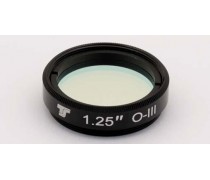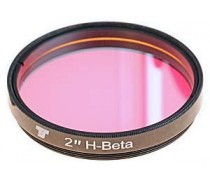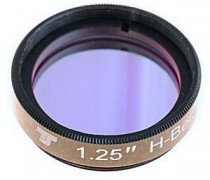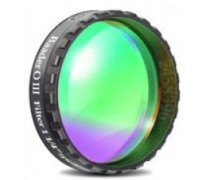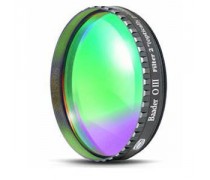Codice articolo: 8h00nn
The Astronomik [S II] filter is a narrow-band-filter for astro photography.The filter lets only the light of the single ionized sulfur ([S II]) pass.
♦ 97% transmission of the [S II] line
♦ FWHM 6 nm
♦ Blocks IR also, necessary for digital photography
♦ Main operational use: planetary nebulae & supernova remnants
♦ Substrate optically polished
♦ No moisture-sensitivity, no aging, and totally scratch-proof
♦ Parfocal with other Astronomik filters
♦ 10 years warranty by manufacturer
♦ Connection: T2-thread
The Astronomik SII filter is a narrow-band-filter for astro photography. The filter lets the light of the ionized sulfur [S II] pass, and blocks nearly the whole remainder of the visual spectrum as well as IR, in which the sensor is sensitive.
The full width at half maximum (FWHM) of 6 nm is optimal suitable for common astro cameras and allows the use of very fast optics. The range of application extends from 1:2.8 to 1:15. Transmission losses and chromatic distortions, which arise with other filters, only occur with Astronomik filters when extremely bright aperture ratios of 1:2 and more come into play. It should be noted, that the filter has a transmission of up to 99%.
Another advantage of the 6 nm filters is the good availability of guiding stars for cameras with a built-in autoguider (SBIG). If you use a very strong filter like our 6 nm filter, you often won´t find a usable guidestar.
The Astronomik [S II] filter increases the contrast between objects, in this case between those with [S II] emission lines and the skyglow background. Also, our Astronomik [S II] filter completely suppresses the emission lines of artificial lighting (mercury (Hg) and sodium (Na)) and skyglow.
Main use:
The Astronomik [S II] filter increases the contrast between objects, in this case between the [S II] emission line and the skyglow background. The Astronomik [S II] filter completely suppresses the emission lines of artificial lighting (mercury (Hg) and sodium (Na)) and skyglow. Due to the high optical quality of the Astronomik H-alpha filter substrate you will see the same needle-sharp stars as you would from your regular telescope.
Other uses:
♦ Using the H-alpha and the [O III] filters, you can obtain three-color images of emission line objects (gas nebulae) from locations with very strong light pollution. To do so, you would take an image in three different wavelengths, select each one as a color-channel in Photoshop and paste them together as one single color image.
♦ If you plan to create color images from emission line data, our CLS-CCD filter is a great choice for the Luminance channel.
Suitability:
♦ Visual observation (dark skies): Unsuitable
♦ Visual observation (urban skies): Unsuitable
♦ Film photography: It depends, but very long exposure times
♦ CCD and CMOS photography: Very good, huge contrast enhancement at [S II]-emission nebulae
♦ DSLR photography (original): Unsuitable
♦ DSLR photography (astro modified): Very good, huge contrast enhancement at [S II]-emission nebulae
♦ DSLR photography (MC modified): Very good, huge contrast enhancement at [S II]-emission nebulas
♦ Webcam / Video (Planets): Unsuitable
♦ Webcam / Video (Deep Sky): Unsuitable
Technical Data:
♦ Transmission of over 97% with the [S II] line (672 nm)
♦ Complete blocking of all disturbing wavelength ranges in the infrared
♦ Parfocal with other Astronomik filters
♦ Glass thickness: 1 mm
♦ Completely resistant against high humidity, scratches and aging effects
♦ Diffraction limited, the filter will not reduce the optical performance of your telescope!
♦ Astronomik filters are delivered in a high-quality, long lasting, filter box
Filter transmission curve:
♦ The horizontal axis is the wavelength in nanometers (nm). 400 nm is deep blue, at 520 nm the human eye senses green and at 600 nm red. At 656 nm is the famous "H-Alpha" emission line of hydrogen.
♦ The transmission in % is plotted on the vertical axis.
♦ The red line shows the transmission of the filter.
♦ Visual filters: The grey line in the background shows the relative sensitivity of the human eye at night. The maximum is at ~510 nm and drops to longer and shorter wavelengths. You can easily see, that you can´t see anything of the H-alpha line at night (even if you can during daylight!) The sensitivity at 656 nm is 0% at night!
♦ Photographic filters: The grey line in the background shows the sensitivity of a typical astro camera sensor.
♦ The most important artifical emission lines are shown in orange. The artifical light pollution is dominated by see mercury (Hg) and sodium (Na), which are used in nearly all streetlights.
♦ The most important emission lines from nebulas are shown in green. The most important lines are from ionized hydrogen (H-alpha and H-beta), double ionized oyxgen ([O III]) and ionized sulfur ([S II]). The square brackets indicate that these lines are forbidden.
Specifiche tecniche:
| Transmission of the [S II] line at 672 nm: | 97% |
| IR blocking: | yes |
| Main operational use: | Planetary nebulae & supernova remnants |
| Anti reflective coating: | No moisture-sensitivity, no aging, and totally scratch-proof |
| Substrate: | optically polished substrate |
| Parfocal: | With all other Astronomik filters |
| Glass thickness: | 1 mm |
| Filter cell material: | Aluminum |
| Filter cell thickness: | 7.5 mm (without male thread) |
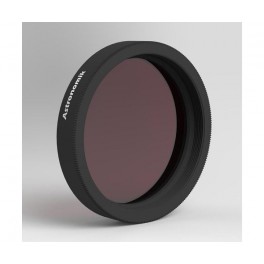 Ingrandisci
Ingrandisci 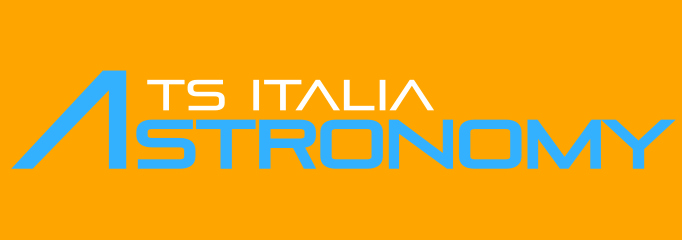
![[DEMO] ASI2600MC DUO](https://www.teleskop-express.it/img/p/1/0/0/3/9/10039.jpg)
![[USATO] Fornax 52](https://www.teleskop-express.it/img/p/9/9/2/6/9926.jpg)
![[USATO] Astrografo RASA 11″](https://www.teleskop-express.it/img/p/9/1/8/7/9187.jpg)

![The Astronomik [S II] filter is a narrow-band-filter for astro photography.The filter lets only the light of the single ionized sulfur ([S II]) pass. [EN] The Astronomik [S II] filter is a narrow-band-filter for astro photography.The filter lets only the light of the single ionized sulfur ([S II]) pass. [EN]](https://www.teleskop-express.de/shop/Bilder/shop/astronomik-filter/astronomik-succd-kurve.jpg)

